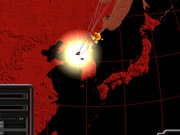SuperPower 2 Hands-On Impressions
We get a chance to wage some nuclear warfare in an early version of this upcoming geopolitical strategy game.
To most gamers, strategy games tend to either be real-time affairs such as Warcraft III or turn-based games like Civilization III. But then there's SuperPower 2, which is a massive geopolitical game that takes strategy to a whole new level. In SuperPower 2, you can take charge of any nation on earth and control its political, economic, and military destiny. We've been playing with an early version of the game to get some taste of the power that will be at your fingertips. It should be noted that the preview version we played lacked certain features, such as single-player gameplay and military unit research and design. Still, we were able to get a feel for the gameplay.

The first thing you need to do is choose a country to lead. The natural temptation is to choose the United States due to its superpower status; after all, it's got the largest economy and the most powerful military as well as a huge number of nuclear missiles (more on that later). However, you can easily select any other country, from Afghanistan to Zimbabwe, though you'll probably have to scale down your global ambitions a bit.
You'll play the game from a 3D virtual globe of the world. By clicking on a country, you'll be given its internal political boundaries (such as states), and if you zoom in close enough, roads and terrain features slowly phase into view. The 3D globe has a large number of different filters you can apply, including color coding nations by military strength, economic strength, governmental stability, diplomatic relations, and more. This will allow you to quickly and easily gauge the state of not only your nation but the rest of the world as well.
The interface has been designed to be as user-friendly as possible. All the controls that you need to play the game are found in the top levels of the military, economic, and political windows, all of which can be accessed by clicking on the three buttons in the left-hand corner of the screen. With just a few clicks, we turned the United States from a free-market democracy to a totalitarian police state under martial law with a military government. A few more clicks and we outlawed English and made Spanish the official language; we made all religions illegal, and jacked up the income tax. Needless to say, our popularity took something of a nosedive, but after nuking Canada the approval rating spiked to the mid 30s, though it collapsed again after we launched the remaining missiles in our arsenal at China. Unlike Canada, China has a nuclear arsenal of its own and it managed to launch a retaliatory strike.
As you can probably imagine, nuclear warfare is going to be a highlight of this game. When you call up the nuclear option, you're given a strategic view of the world with all of the nations in red. All you have to do is select a target country and then decide whether you wish to target military targets or civilian targets. You then choose how many missiles to commit to the strike (you can even pick which ones on a list) and the game will give you a causality estimate. Then you hit the ready button and a small window with a red button pops up, and all you have to do is push it. Your missiles will launch, and you can see their trajectories as they arc around the globe before slamming into their targets. Global thermonuclear warfare has never been so simple.
Conventional warfare, though, is going to be your more useful option, for obvious reasons. Though we couldn't design or build any new units, we still managed to invade Canada with the units that the United States had in the beginning of the game. Using a simple click-and-drag interface, you can shift your units around the map and invade other countries. You can also merge units together to create a more powerful military unit. Combat occurs when two units of opposing sides come in contact, at which point the battle is taken out of your hands and you have to wait for the results. Your conventional units will take advantage of the road networks in each country to maneuver, so you can try to place units at blocking locations on the map, like a mountain pass, where they can gain an advantage.
As we noted earlier, there are some features missing in the version we played, but from what we saw the various pieces are falling into place. Though its complexity is sure to make casual strategy fans wary, the original SuperPower still managed to sell more than 200,000 copies, according to publisher DreamCatcher, so there is an audience out there for large-scale geopolitical strategy games. We can expect SuperPower 2 to ship later this year.
Got a news tip or want to contact us directly? Email news@gamespot.com

Join the conversation